How to use a tiller for breaking down the soil? Manually doing it is a laborious task and requires a lot of time. Also, removing the weeds in the process can be a hassle. Using a garden tiller can cut down the time and effort for the same task by less than half.
In this article, we will discuss how to use a tiller, its types, when to use them, and a step-by-step guide to “till” the ground. Also, we will shed some light on the pros of using it in the garden. Let’s get started!
Contents
An Insight Into Using a Tiller in a Garden
Here is a detailed guide on how to use a garden tiller in your garden and how it changes the soil texture!
- Before you do anything, put on safety gear!
- Before tilling, clear out any hazards (rocks, metal scraps, wires/ropes, stones, etc) that could damage the blades of the garden tiller.
- Mark the area you want to till in advance or mark the lines of your path.
- Check the user manual of the tiller machine for any technical and useful information. Now, switch on the machine and adjust the choke.
- Next, dig the land by holding the handles firmly to keep the tiller in place. Once the tiller has a firm grip on the soil. Move forward to “till” the ground.
- You can even move left or right but experts recommend moving in parallel lines in one direction.
- Once you have reached the end of the lawn, rotate the tiller and head back in the opposite direction parallel to the line you can.
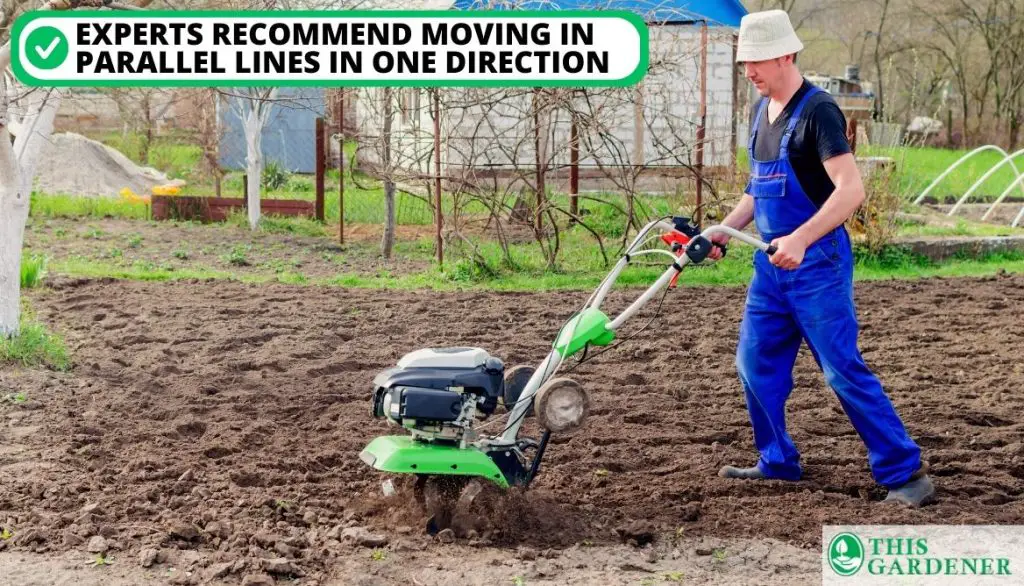
Tiller Types to Use for a Garden
You may use a standard tiller in the garden. But, this scenario changes when the texture of the soil and the size of the garden is different.
You need a heavy-duty tiller for a larger area. If the soil is harder then a standard tiller will not do the job. Let’s get to know about the different types!
Front-Tine Tillers
Front-tine tillers are ideal for removing all the grass in between the rows of plantations in your garden or field.
- These types of machines are fitted with tines (blades) in the front that act like grass cutters. They will “till” the ground, uproot and remove grass, weeds, etc.
- Front-tine tillers break and stir the soil at the same time.
- To move around, they have wheels fitted at the back and you can use it more like a walk-behind mower.
- They are highly affordable and allow ease of use for the gardener.
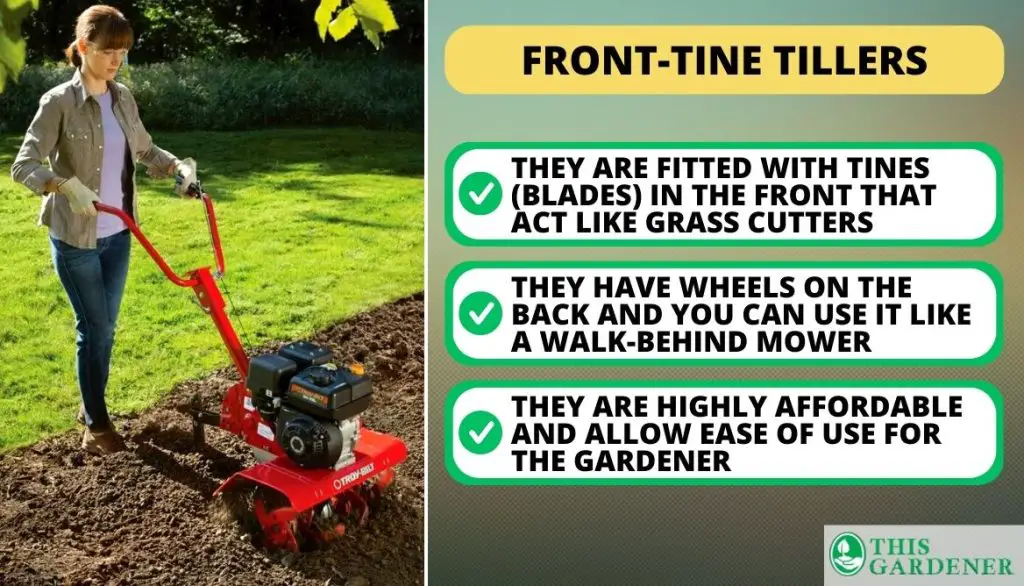
Techniques to Remove Grass and Break Soil
To remove grass and break soil please follow next:
- Hold the tiller firmly as it reaches the desired depth.
- Now apply force to push it forward.
- The front-tine tiller’s tines propel forward by manual force as it does not have drive wheels.
- A strong grip and consistent movement will ensure that you achieve excellent results to remove grass and break the soil.
For more details, check out this video.
Rear-Tine Tillers
The rear-tine tillers are more suitable for harder soil.
- They have blades at the rear side to remove grass and their engine is located at the front. They deliver more power as compared to the front-line models.
- Rear-tine tillers are bigger, heavier, and more powerful specially designed for fields that have at least 16 inches of distance between the rows of crops/plants.
- Although they are pricier, they offer users automation to reduce the effort required.
- They are fitted with drive wheels that help to propel the tiller without the need to apply force to push it manually and control the depth of tilling.
- A lightweight tiller will most likely move around from its path but the weight of the rear-tine tiller helps you avoid this problem.
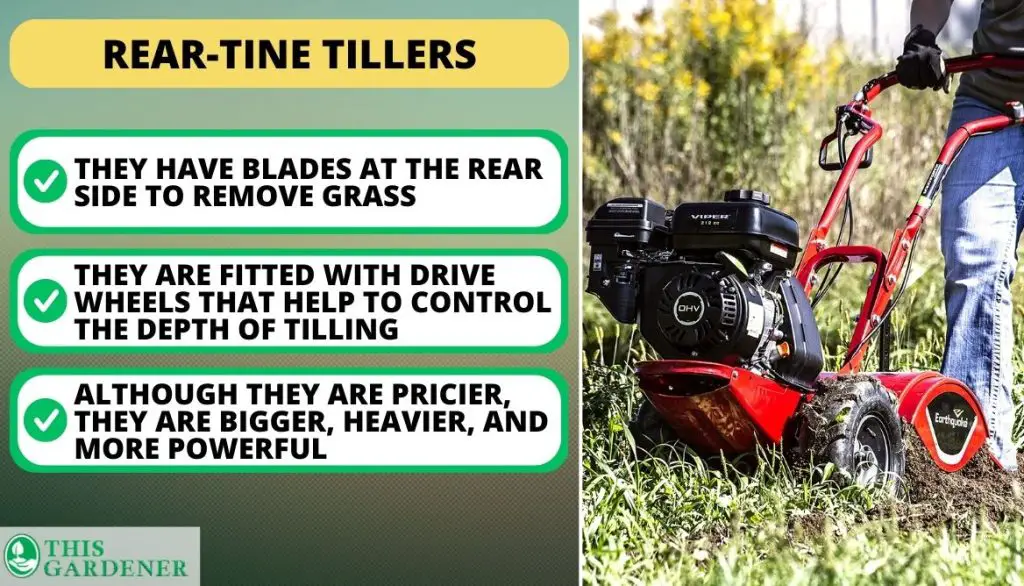
Techniques to Remove Grass and Break Soil
Do next to remove grass and break soil:
- Tilt back the tiller, and bring it to your desired location.
- Now make adjustments to the depth of tines into the soil, and the height of the handles, and then engage the tiller ready.
- You need a firm grip on the handles to control the tiller machine and move slowly for efficient results.
- Moving in a long and straight line is the best technique.
- If the ground needs more tilling then move in a perpendicular pattern to avoid overworking the soil in one row.
- Moving forward making a consistent pattern also allows you to remember your single pass and start a new row.
Check out this video for further details.
Uses of a Garden Tiller
A garden tiller offers numerous benefits when used in your garden. Listed below are some of the functions of a garden tiller. Let’s check it out!
- Using a tiller can help in boosting the nutrient levels in the soil. E.g., phosphorus, nitrogen, etc.
- Tilling breaks the top layer of the soil for better plant growth.
- Mixes the organic material to make it fertile.
- Increases the absorption of water into the soft soil after stirring it.
- Excellent for mixing compost/fertilizer to change it into mulch.
When is the Best Time to Use a Garden Tiller?
The best seasons to use a garden tiller in your garden are autumn and spring. Whenever you decide to use the tiller in your garden, keep in mind to not use it if the soil is too wet.
This will stir the soil in such a manner that clumps will form once it dries. You do not want that to happen as it will increase the work even more!
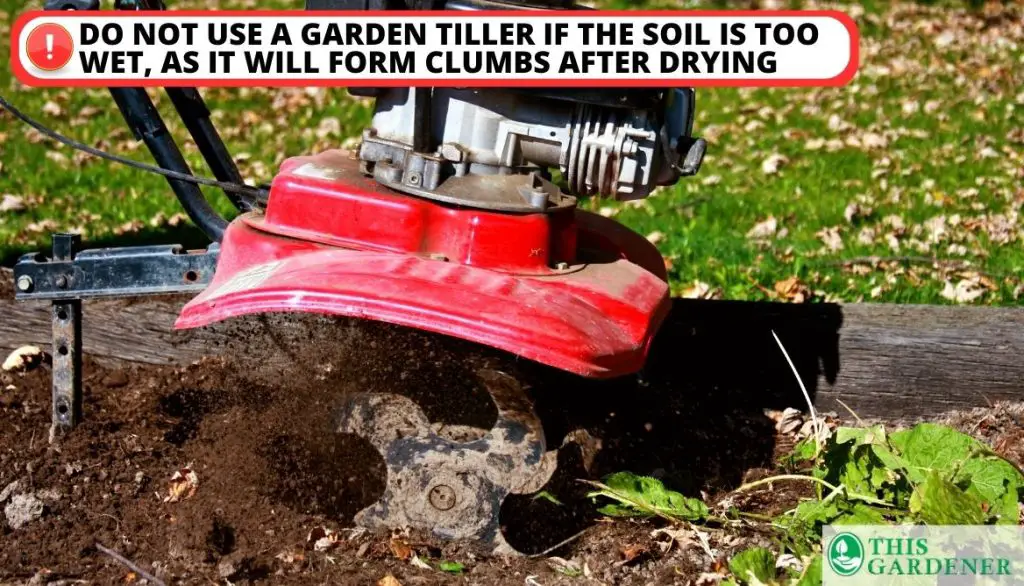
- To make things easier, use a tiller on your garden for at least 2-3 days after the recent rain.
- The ground will be in excellent moist condition (not too muddy or wet).
- Although, if there is no chance of rain then you can always use a hose or garden sprinklers to get the same results.
Step-by-Step Guide: How to Use a Tiller for Grass Removal
Manually removing grass from the lawn can be a challenging and time-consuming job. The roots of the grass grow deep into the soil. To make things easier, use a garden tiller to save time and effort. A tiller performs grass removal efficiently and here is how it is done!
1. Clean the Entire Area First
Before doing anything inspect the area. There may be tall grass, rocks, metal pieces, stones, or large weeds.
- The tiller is not able to break through very hard substances instead the blades can get damaged if you are not careful.
- Even a heavy-duty tiller is unable to break down rocks or cut through metal.
- Clean the area and ensure that the ground is machine friendly.
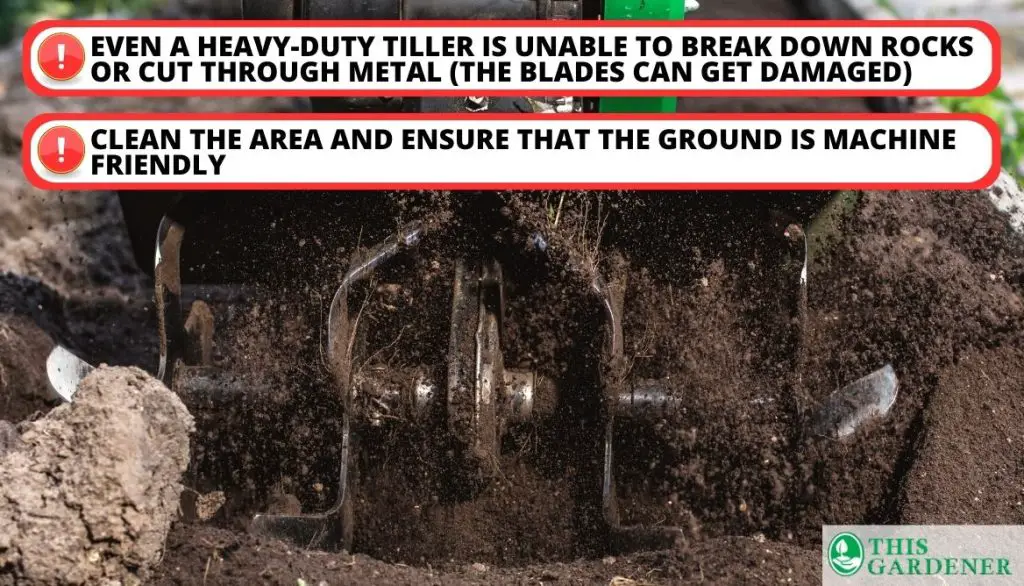
2. Make the Land Semi-Dry
Solid and dry soil poses a problem for the tiller.
- You have to water it and ensure that it is semi-dry.
- Do not water a lot and make it into a mud puddle. The blades will create a mess if the water in the soil is too much.
- You just need to soften the soil enough for the blades to cut through easily.
3. Prepare the Tiller Machine
Selecting the right type of tiller for the right type of soil is essential.
- If the area is small then a standard-sized tiller will do the trick.
- If the area is large then using a commercial tiller is the best choice.
- Using an electric tiller also adds electric cost and using it on a large area is not recommended.
4. Protective Equipment for Safety from Rotating Blades Underneath
Protective gear is always necessary when you use any type of machinery to work.
- While using the tiller, put on closed-toed shoes, and wear a jacket, pants (full-length), pair of gloves, and safety glasses.
- Make sure to read the manufacturer’s instructions to understand how the machine works.
- Never leave the tiller machine running and unattended! If you need to rest then turn the machine off.
- The tiller works at a specific speed and you need to match that pace. You need to match the tiller’s speed and not move too fast.
5. Dig the Tiller Blades to the Bottom for Removing Grass
Follow these instructions to make sure the process is done correctly.
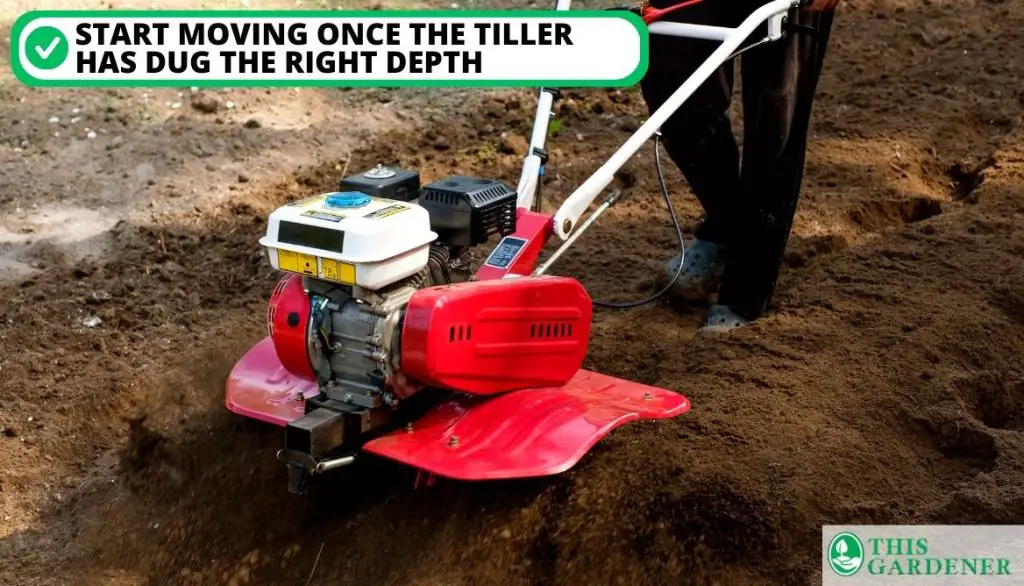
- Set the tiller in the right direction and press the clutch lever.
- The blades have to dig into the soil first. Start moving once the tiller has dug the right depth.
- Move ahead slowly so that the tiller can break down the soil with the rotating blades underneath and check your path so that you are moving in a perfect parallel line.
6. Follow a Pattern with Tine Tillers
Moving in an organized way is the key to breaking the soil on the ground efficiently. Make sure not to miss a single inch when you move around. Also, ensure that the soil is properly stirred on each pass you make with the tiller.
Our Verdict for the Tilling Process
As long as you are taking safety precautions, using proper safety gear, cleaning the location before tilling, and following instructions then tilling is safe whether you use a rear-tine or a front-tine tiller. If you are still unsure about the proper usage of a tiller then it is better to consult a professional for help.
Below are some of the pros, check them out!
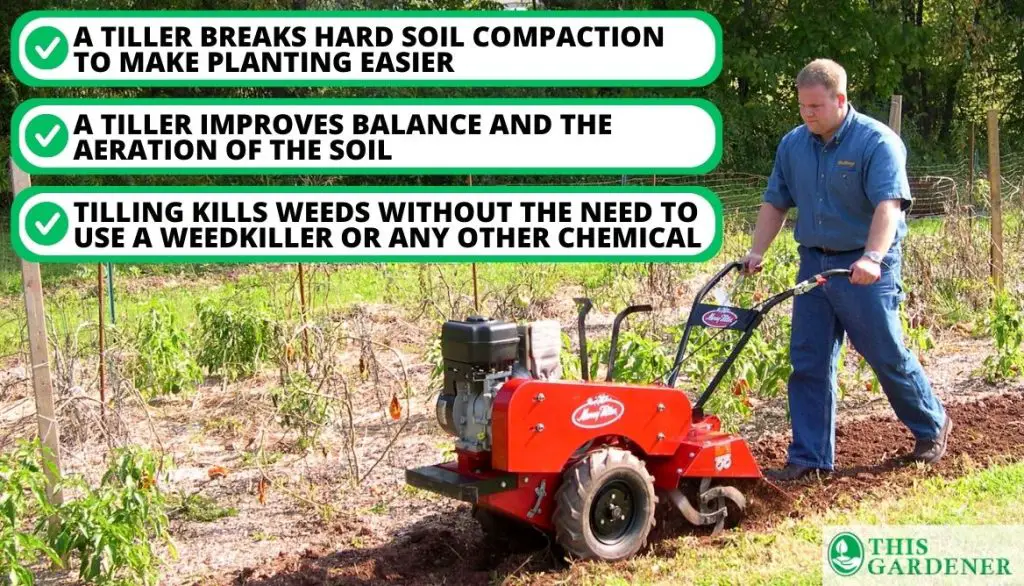
- A tiller will level the ground and make it flat with the help of its blade.
- Breaks hard soil compaction to make planting easier.
- You can easily dig deeper holes into the ground for planting different species of plants, trees, or bushes.
- Helps maintain a clean and ideal garden.
- Improves the aeration of the soil by distributing air into the broken-down particles.
- Tilling kills weeds without the need to use a weedkiller or any other chemical.
- Improves balance by distributing the nutrients of the soil.
FAQ
When should you use a tiller?
You used a tiller if you are breaking new ground, the ground is rocky or heavily weeded, or the compacted soil needs to be loosened.
What do you do with a tiller?
A tiller is an excellent machine to kill weeds and it can even break the soil to bring up any dormant weed seeds buried beneath.
How do you engage a tiller?
You need to engage the drive and slowly create parallel lines to loosen the compacted soil. Tilling is similar to mowing the lawn. Use a shallow tilling depth if the soil is too dry.
Does tilling hurt the soil?
Tilling can hurt the soil if it is done frequently. But, if required, tilling can be healthy for the soil and the crops you are growing as it readies the soil for organic material to be mixed.
What is the difference between a tiller and a rotavator?
The difference between a tiller and a rotavator is the nature of their use. A tiller is used for lighter work where the top layer of the soil needs to be broken down. While the rotavator (larger tiller) is used for heavier work on an entire land.
Conclusion
The big question of “how to use a tiller” has been covered excellently in this article. Operating a tiller is easy as long as you follow the safety precautions, and keep track of the controls. Whether you use a standard or a heavy tiller, ensure that you have a firm grip on the handles and never perform tilling on rocky surfaces or uneven ground.
Ultimately, tilling reduces cost and effort while saving your time in the long run. And its benefits are countless such as softening the ground and killing weeds. Which tiller do you use and what method do you prefer for tilling? Let us know in the comments section!
- How to Get Potatoes to Sprout Eyes: Detailed Growing Guide with 3 Options - July 31, 2023
- Weight of a Medium Potato: Revealed in Detailed Guide - July 29, 2023
- Maris Piper Potatoes: 9 Substitutes You Should Know About - July 27, 2023
Hello! I’m Jessica Zander, a garden coach and consultant based in the Boston area (zone 6b), offering virtual consultations across the country and Canada.
I’ve been passionate about gardening since the early 1990s, and in 2022, I launched You Can Do It Gardening to empower individuals to feel more confident in their gardening endeavors.
Following a 30-year career in nonprofit finance and operations, I transitioned out of that field in mid-June of 2023 due to the growing demand for coaching services. Interestingly, my years of presenting financial statements to boards and finance committees proved to be valuable experience for teaching people about gardening! I enjoy sharing skills, providing guidance and suggestions, and collaborating efficiently with clients to make significant improvements to their outdoor spaces, both small and large. I also regularly teach at the Arlington Continuing Education and Cambridge Adult Education.
My approach is direct and practical, akin to Mary Poppins, but tailored to your garden. Clients find satisfaction in saving money and taking pride in their own gardening achievements.

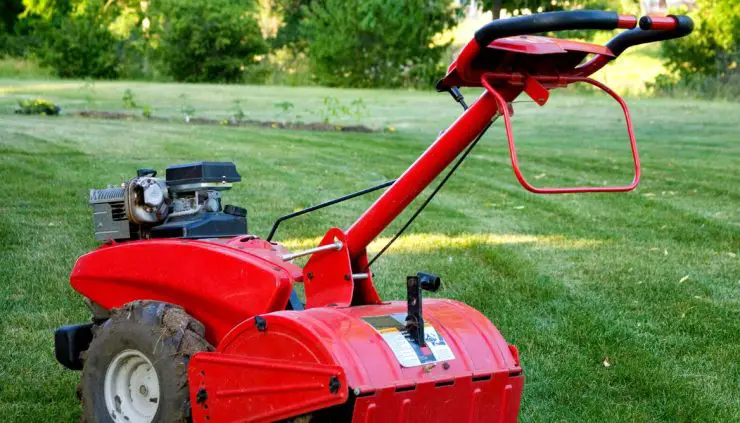

Add comment